Selecting the perfect canvas size can dramatically enhance the impact of your artwork, photography, or decor. Whether crafting a gallery wall or choosing a stand-alone statement piece, the canvas size shapes how your art complements its space, ensuring a balanced and engaging display.
Various choices are available, from versatile standard sizes—small, medium, and large—to unique custom dimensions and oversized options. This guide breaks down standard, custom, and specialty sizes with dimensions to help you find the ideal canvas for everything from home decor to professional art showcases, giving you the insights to match your vision and space perfectly.
Standard Canvas Size Chart – All Formats
| Format | US Size (inches) | European Size (cm) | Best Use |
| Small Rectangular | 5 × 7 | 13 × 18 | Desk display, shelf art |
| Small Rectangular | 8 × 10 | 20 × 25 | Standard photo displays |
| Small Rectangular | 11 × 14 | 28 × 36 | Traditional portraits |
| Small Square | 8 × 8 | 20 × 20 | Accent walls, small nooks |
| Small Square | 10 × 10 | 25 × 25 | Bathroom art, kitchen decor |
| Medium Rectangular | 12 × 16 | 30 × 40 | Above furniture |
| Medium Rectangular | 16 × 20 | 40 × 50 | Home gallery |
| Medium Rectangular | 18 × 24 | 45 × 60 | Feature pieces |
| Medium Square | 12 × 12 | 30 × 30 | Wall groupings |
| Medium Square | 16 × 16 | 40 × 40 | Statement pieces |
| Large Rectangular | 20 × 24 | 50 × 60 | Living room art |
| Large Rectangular | 24 × 30 | 60 × 75 | Large wall spaces |
| Large Rectangular | 24 × 36 | 60 × 90 | Panoramic views |
| Large Rectangular | 30 × 40 | 75 × 100 | Feature walls |
| Large Square | 20 × 20 | 50 × 50 | Room focal points |
| Large Square | 24 × 24 | 60 × 60 | Large spaces |
| Extra-Large Square | 30 × 30 | 75 × 75 | Dining room features |
| Extra-Large Square | 36 × 36 | 90 × 90 | Entry hall statements |
| Extra-Large Square | 40 × 40 | 100 × 100 | Grand spaces |
Standard Canvas Sizes and Shapes Guide
Understanding standard canvas sizes makes choosing and buying artwork much easier. Consider these standard sizes like clothing sizes – they’re created to fit most needs and simplify your shopping. Let’s explore the most common canvas formats and when to use them.
Rectangular Canvas Sizes
Rectangular canvases provide a classic format for various art styles and photography. They’re available in vertical (portrait) and horizontal (landscape) orientations, making them adaptable to different wall spaces and room designs.
- Small Sizes (5” x 7”, 8” x 10”): Perfect for smaller spaces, these canvases are often used for personal or desk displays, family photos, or small art prints. They add a subtle touch without overpowering a room.
- Medium Sizes (11” x 14”, 16” x 20”): These are popular sizes for framing single pieces of wall art. Their dimensions work well in almost any room, providing a balanced presence on walls, whether alone or grouped in a gallery wall.
- Large Sizes (18” x 24”, 24” x 36”): Larger rectangular canvases make a bold statement and are suited for feature walls or central focal points in living rooms, bedrooms, or entryways. They work incredibly well for landscape photography, portraits, and abstract art.
Square Canvas Sizes
Square canvases are excellent for creating a modern, balanced aesthetic. Their symmetrical shape makes them well-suited for minimalist and contemporary decor, and they often draw attention with their clean, equal proportions.
- Small Sizes (8” x 8”, 10” x 10”): These small square canvases are great for displaying close-up photography, compact artwork, or accent pieces. They’re easy to integrate into gallery walls or to use in small spaces like bathrooms and bedside tables.
- Medium Sizes (12” x 12”, 16” x 16”): Medium square canvases work well on their own or in groups, offering a balanced look for medium-sized spaces. Due to their centered composition, they’re popular choices for portraits and family photos.
- Large Sizes (24” x 24”, 30” x 30”): Large square canvases can anchor a space with their solid, bold appearance. They’re a favorite for abstract and modern art, providing ample space to showcase details and textures. Ideal for statement pieces, these sizes often serve as a room’s visual centerpiece.
Standard canvas sizes take the guesswork out of choosing dimensions for your artwork. They’re tried and tested proportions that work well in most spaces. Whether you’re creating a gallery wall or selecting a single statement piece, starting with standard sizes helps ensure your art will look professionally displayed.
Remember that these standard sizes serve as helpful guidelines rather than strict rules. They’re designed to make your art-buying experience easier while ensuring your finished piece looks great in your space.
Specialized Canvas Sizes
Specialized canvases include unique shapes and dimensions, from mini-sizes to extra long and tall-narrow sizes designed for specific display needs.
Mini Canvas:
These miniature canvas sizes include 2” x 2”, 3” x 3”, 4” x 6” or 5” x 5”, and are perfect for small spaces or thoughtful gifts.
These compact sizes work well on shelves, desks, or as part of a gallery wall. Often used for personal keepsakes or sentimental gifts, they allow for unique, small-scale displays that won’t overpower the area.
Mini canvases also suit DIY projects and collectible sets, adding charm to desks, dorms, and tight wall spaces.
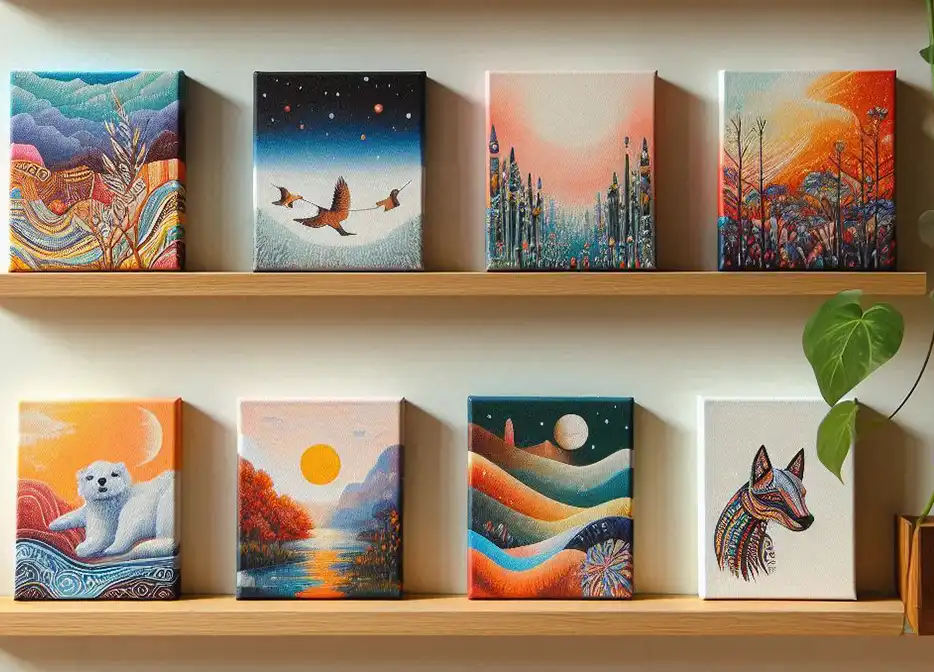
Oblong Canvas
These tall vertical rectangle prints feature a rectangular shape with a noticeably longer length than width, often in aspect ratios of 1:2 or more.
This style is ideal for vertical or horizontal compositions that require a unique, elongated look.
Standard sizes include 10×20, 12×24, and 16×32 inches, providing ample space for art that suits narrow wall spaces.
Panoramic Canvas
These are long horizontal rectangle prints tailored for capturing wide-view scenes, such as landscapes, with aspect ratios typically around 1:2.5 or greater.
These extra-wide canvases, available in sizes 12×36, 20×60, and 24×72 inches, emphasize sweeping views and work well in spacious areas, creating a captivating focal point in any room.
Extra-Large/Giant Canvas Sizes
Extra-large canvases fill expansive spaces like living room walls or entryways. These sizes create a dramatic focal point and are ideal for impactful artwork or large-scale photography.
- Extra-Large: 36” x 48”, 36” x 36”, 30” x 60”, 40” x 60”
- Oversized: 40” x 40”, 48” x 72” and beyond – Great for large open areas or gallery-style settings.
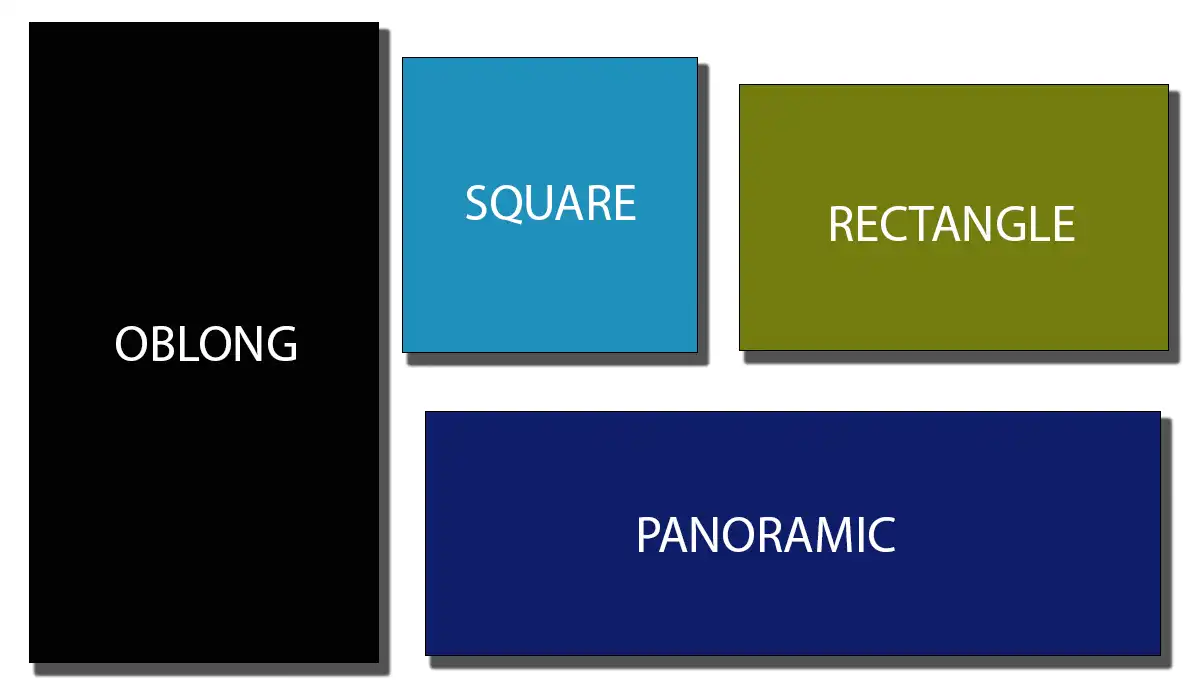
Custom Sizes
Many art and decor stores provide custom canvas dimensions to suit unique spaces and unconventional wall layouts.
Custom sizes allow for creative freedom, letting you match specific room designs or fit awkward spaces perfectly.
This flexibility is ideal for non-standard frames, oversized wall art, or gallery walls that need a special touch.
Custom canvases are ideal for unique artwork or installations that require exact sizing for the best visual impact.
Other Shapes & Dimensions
Circle Canvas
Circular canvases come in sizes ranging from small (10″ diameter) to large (up to 30″ or more) and are ideal for modern and artistic settings. Their round shape draws attention, making them perfect for abstract art, landscapes, and unique focal pieces.
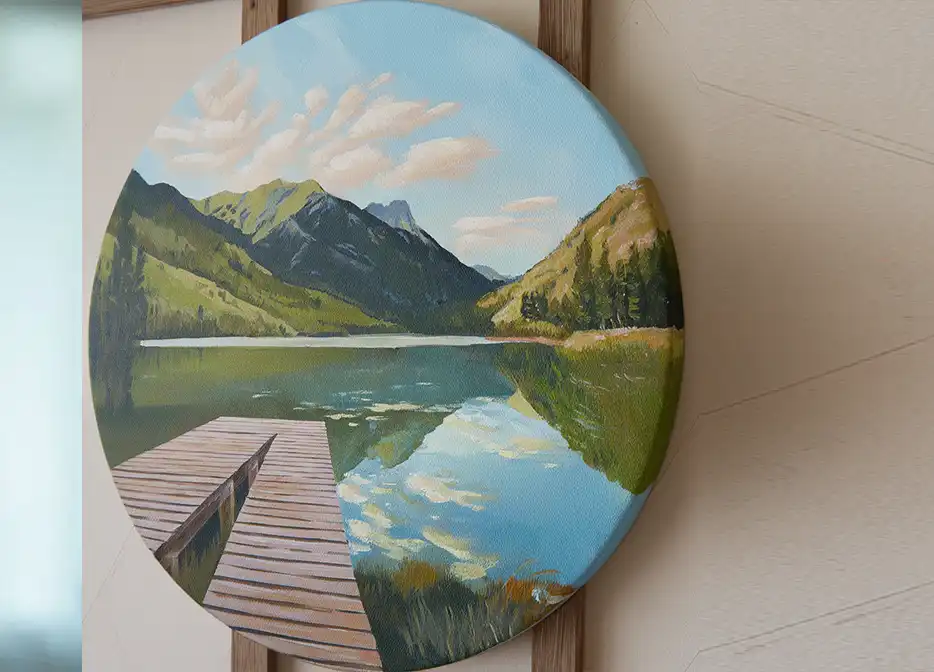
Oval Canvas
Oval canvases are a classic choice, often used for portraits and vintage-style decor. Available in various sizes, they add a touch of tradition and elegance, complementing Victorian or rustic interior themes.
Irregular Shapes
Specialty canvases in unique shapes—such as hexagons or heart shapes—offer creative ways to display art. They are ideal for customized designs, children’s rooms, or eclectic decor styles, adding a playful or bespoke touch to any space.
Common Canvas Size Categories
Understanding canvas size categories helps you narrow down your choices quickly. Like clothing, which comes in small, medium, and large, canvases follow similar groupings to make selection easier. Let’s explore each category and learn when to use it.
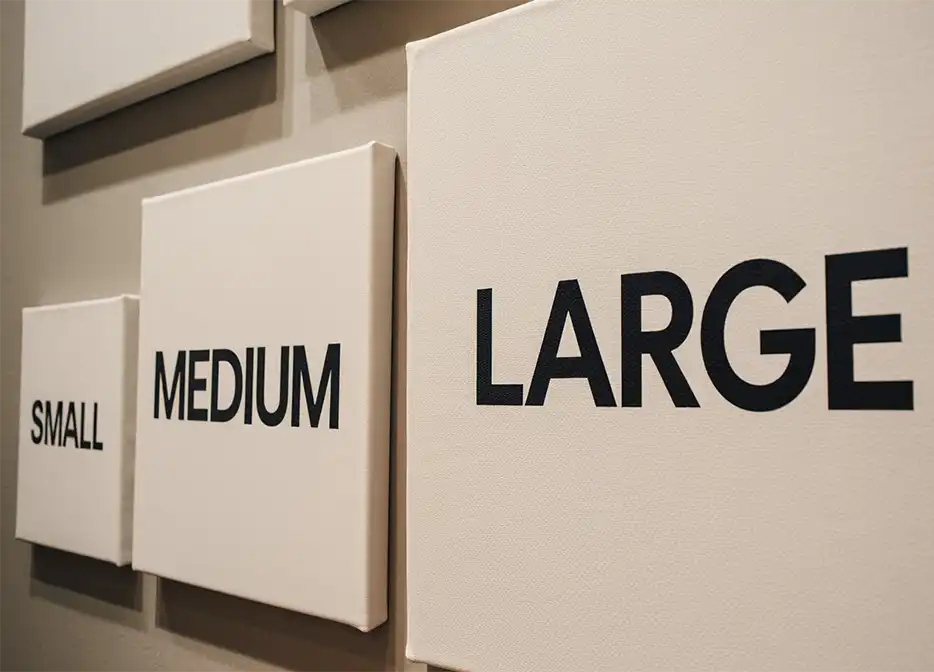
Small Canvas Dimensions
Small canvases work wonderfully in cozy spaces and intimate settings. These compact sizes pack a punch without overwhelming your walls.
Small canvases typically range from 5×7 inches up to 8×10 inches. They’re perfect for:
- Personal photos on desks or shelves
- Creating gallery walls with multiple pieces
- Decorating narrow wall spaces
- Adding art to small rooms like bathrooms
- Student art projects and practice pieces
Medium Canvas Dimensions
Medium canvases are the most versatile and popular choice for home décor. These sizes command attention while fitting comfortably in most rooms.
Medium sizes typically span from 11×14 inches to 18×24 inches. They excel at:
- Displaying family portraits
- Creating focal points above furniture
- Showcasing landscape photography
- Adding impact to dining room walls
- Professional artwork presentations
Large Canvas Dimensions
Large canvases make bold statements and transform spaces. They become the center of attention in any room they occupy.
Large canvas sizes start at 24×36 inches and can go up to 30×40 inches. They’re ideal for:
- Creating dramatic focal points
- Filling large wall spaces
- Corporate lobbies and offices
- Hotel and restaurant décor
- Grand entrance halls
Popular Canvas Sizes for Different Uses
Different types of artwork and photos need different canvas sizes to look their best. Just like you wouldn’t wear beach clothes to a formal dinner, certain canvas sizes work better for specific purposes. Let’s explore the best sizes for different types of art and photography.
Painting Canvas Sizes
Abstract Art
Abstract paintings can be done at any size, but larger canvases like 36×48 inches often create more impact. The extra space lets colors and shapes breathe and allows viewers to spot interesting details. Smaller abstract pieces, at 16×20 inches, work well in groups.
Traditional Paintings
Traditional subjects like still life or portraits typically look best in medium sizes. An 18×24-inch canvas gives enough room for detail without overwhelming the subject. Larger pieces, at 24×36 inches, work well for more complex scenes.
Modern Art
Contemporary artwork often pushes size boundaries. Square canvases at 24×24 inches or 36×36 inches create strong geometric impact, and extra-large sizes like 48×60 inches make bold statements in modern spaces.
Multi-Panel Arrangements
Diptychs (Two Panels)
Two-panel artwork requires careful size selection. Common combinations include two 16×20-inch canvases or two 24×36-inch panels. The total display should fit your wall space while leaving proper spacing between pieces.
Triptychs (Three Panels)
Three-panel displays often use equal-sized canvases. Popular choices include three 16×20-inch pieces or three 20×24-inch canvases. Some artists use a more prominent center panel with smaller side panels for added interest.
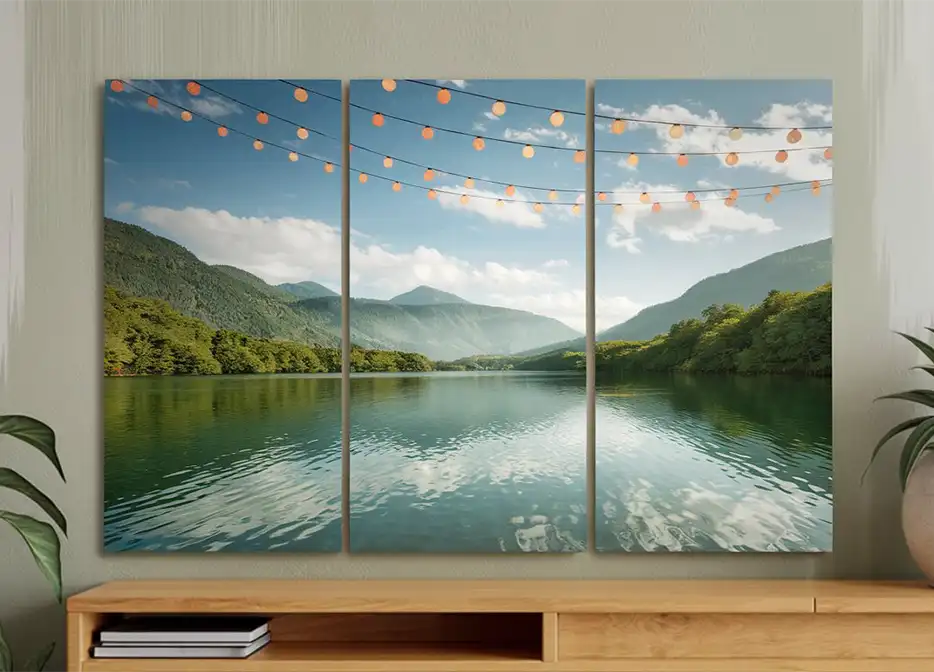
Gallery Walls
Gallery walls mix different sizes for visual interest. To create dynamic arrangements, combine several small pieces (8×10, 11×14 inches) with medium pieces (16×20, 18×24 inches). Leave 2-3 inches between pieces for proper spacing.
Photography Canvas Dimensions
Portrait Photography
Portrait photos need sizes that showcase faces and expressions. The most flattering sizes include 16×20 inches and 24×36 inches. These dimensions give enough space to capture personality while keeping facial features crisp and clear.
Consider going larger with 30×40 inches for family portraits to show group details comfortably.
Landscape Photography
Nature and landscape photos often need wider formats to capture scenic views. Popular sizes include 24×36 inches and 30×60 inches. These wider dimensions help viewers feel like they’re looking through a window at the scene.
Panoramic sizes like 20×60 inches work exceptionally well for sweeping vistas and coastlines.
Wedding Photograph
Wedding photos deserve special attention to size. Critical moments like the first kiss look stunning at 20×24 inches, while full-length dress shots might need 24×36 inches. Group shots often require larger sizes, like 30×40 inches, to show everyone clearly.
Understanding Canvas Measurements
Getting canvas measurements right makes all the difference between artwork that fits perfectly and pieces that look awkward on your walls. Let’s break down everything you need to know about measuring and understanding canvas sizes.
Measurement System (Inches/Centimeters)
In North America, canvas sizes typically use inches, while European and many international markets use centimeters. Here’s how to work with both:
Inches (US Standard):
- Most common in US stores and online shops
- Written as width x height (example: 16×20 inches)
- Easy to measure with standard tape measures
Centimeters (Metric):
- Used internationally
- Written as width x height (example: 40×50 cm)
- More precise detailed measurements
Quick conversion tip: To convert inches to centimeters, multiply by 2.54. For example, a 16×20 inch canvas is roughly 40×50 centimeters.
Aspect Ratios
The aspect ratio tells you the relationship between width and height. Think of it like your TV screen’s shape. Common ratios include:
4:3 Ratio:
- Traditional photo shape
- Examples: 8×10, 16×20 inches
- Great for traditional portraits
3:2 Ratio:
- Modern camera standard
- Examples: 12×18, 24×36 inches
- Perfect for landscapes
1:1 Ratio:
- Square format
- Examples: 12×12, 24×24 inches
- Ideal for Instagram photos
Canvas Depth(Thickness)
Canvas depth matters, too. Standard options include:
- ¾ inch: Slim profile, suitable for framing
- 1½ inch: Standard gallery wrap
- 2-inch: Deep gallery wrap for a modern look
Further Reading
What to Consider When Choosing Canvas Size
Selecting the correct canvas size goes beyond aesthetics—ensuring your art complements its environment and looks great on display. Here are some factors to keep in mind when deciding on canvas dimensions:
1. Your Space
- Room Size: Larger rooms, like living rooms, can accommodate more enormous canvases, while small spaces benefit from compact or mini canvases.
- Wall Space: Measure the wall where you plan to hang the canvas to prevent the artwork from overpowering or getting lost in the area.
- Viewing Distance: Consider the ideal distance to view the artwork. Larger canvases work best in open spaces, while smaller canvases suit tighter areas.
2. Aspect Ratio
- Image Shape: The aspect ratio (the relationship between width and height) affects how the artwork fills the canvas. A long rectangle ratio works well for panoramas, while square canvases suit symmetrical or abstract designs.
- Consistency: If you plan to group multiple canvases in a gallery wall arrangement, maintaining consistent aspect ratios creates a harmonious look.
3. Canvas Type and Material
- Canvas Thickness: Canvases come in various thicknesses, from standard (0.75″) to gallery-style (1.5″ or more). Thicker canvases have a more substantial, modern feel and don’t require framing, while thinner ones fit well in frames.
- Material Quality: Higher-quality materials, like 100% cotton or linen, can impact the vibrancy and longevity of the print, especially for artwork that may be exposed to light or moisture.
4. Canvas Weave
- Texture Preference: Heavier weaves create a bolder texture and add depth to paintings, while finer weaves offer a smooth finish ideal for detailed photography or realistic portraits.
- Artwork Compatibility: Abstracts and impressionistic works benefit from textured weaves, while photo-realistic and highly detailed pieces look best on smoother surfaces.
5. Framing Needs
- Framing Style: Some canvases look best without a frame, while others gain an elevated appearance with a floating or traditional frame. Consider your décor style and decide if framing is needed.
- Budget for Framing: Framing can add to the overall cost, so budget accordingly if you plan to frame multiple pieces.
6. Budget
- Initial Investment: Larger canvases and high-quality materials generally cost more. Factor in your budget to balance size, quality, and quantity.
- Long-Term Value: Investing in a well-made canvas that fits your space can offer long-term enjoyment and durability. High-quality canvases, especially those protected from UV light and moisture, tend to last longer without fading or warping.
Considering these factors, you can select a canvas size that complements your artwork, fits your space, and aligns with your style preferences and budget.
Common Canvas Size Mistakes
Choosing the right canvas size can be tricky, and there are a few common pitfalls to avoid. Here’s a look at the mistakes people often make and how you can steer clear of them:
1. Choosing a Size That’s Too Small for the Space
- Mistake: Small canvases can get lost on large walls, making them look underwhelming.
- Solution: Measure the wall space and go for larger or multiple panels to fill the area proportionally. Generally, artwork should cover about 60-75% of the wall width where it’s hung.
2. Ignoring Viewing Distance
- Mistake: A large, detailed canvas in a small space may overwhelm viewers who can’t step back to see it fully.
- Solution: Consider the space between the viewer and the artwork. Smaller or medium canvases are best for tight areas, while larger canvases work well for spacious rooms.
3. Not Accounting for Aspect Ratio
- Mistake: Using a canvas shape that doesn’t match the image can lead to awkward cropping or stretching.
- Solution: Choose a canvas with an aspect ratio that fits your image. For example, panoramic shots work best on wide rectangular canvases, while symmetrical compositions suit square canvases.
4. Misjudging Weight and Hanging Requirements
- Mistake: Larger or thicker canvases can be heavy, leading to wall damage if not securely hung.
- Solution: Use proper wall anchors or hooks suited for the canvas’s weight. Check whether the wall type (drywall, plaster, concrete) can support the canvas.
5. Neglecting Frame and Border Choices
- Mistake: Some people select a size without determining whether they’ll frame the canvas, which can alter the final dimensions.
- Solution: If you plan to add a frame, allow space for the frame’s width when deciding on your canvas dimensions to avoid overcrowding.
6. Inconsistent Sizing in Gallery Walls
- Mistake: Randomly chosen sizes for gallery walls can look cluttered and disorganized.
- Solution: Plan a layout with consistent sizing or combine sizes that follow a clear pattern when creating a gallery wall. This creates a more cohesive and visually appealing display.
7. Overlooking Lighting and Glare
- Mistake: Glossy canvases near windows or bright lights can produce glare, reducing visibility and detail.
- Solution: Assess the room’s lighting and consider matte finishes if glare might be an issue. Place canvases in areas where the lighting complements the artwork.
By being mindful of these common mistakes, you can select a canvas size that looks balanced, fits your space, and enhances the visual impact of your artwork.
What is the largest canvas size you can buy?
The largest standard canvas size is typically 48 inches x 96 inches (approximately 122 cm x 244 cm). However, depending on the manufacturer, custom sizes can be ordered to be even larger.
What are the smallest canvas sizes?
The smallest standard canvas sizes are generally:
2 inches x 2 inches (5 cm x 5 cm) for mini canvases.
4 inches x 6 inches (10.2 cm x 15.2 cm) for small canvases.
How big is an A3 canvas?
An A3 canvas measures 297 mm x 420 mm (approximately29.7 cm x 42 cm or 11.7 inches x 16.5 inches).
How big is an A5 canvas?
An A5 canvas measures 148 mm x 210 mm (approximately 14.8 cm x 21 cm or 5.8 inches x 8.3 inches).
How big is an A4 canvas?
An A4 canvas measures 210 mm x 297 mm (approximately 21 cm x 29.7 cm or 8.3 inches x 11.7 inches).
How big is an A2 canvas?
An A2 canvas measures 420 mm x 594 mm (approximately 42 cm x 59.4 cm or 16.5 inches x 23.4 inches).
How big is an A1 canvas?
An A1 canvas measures 594 mm x 841 mm (approximately 59.4 cm x 84.1 cm or 23.4 inches x 33.1 inches).

